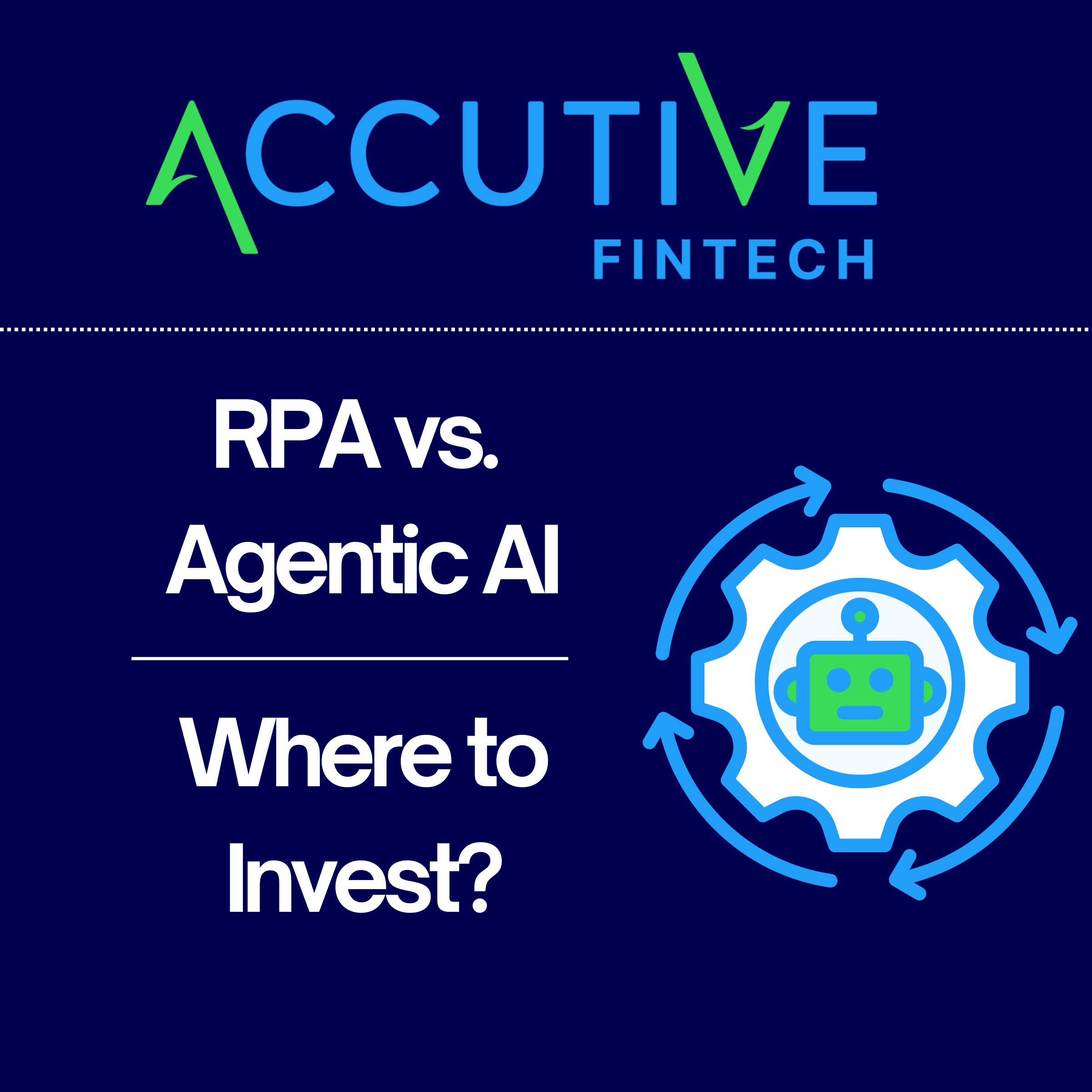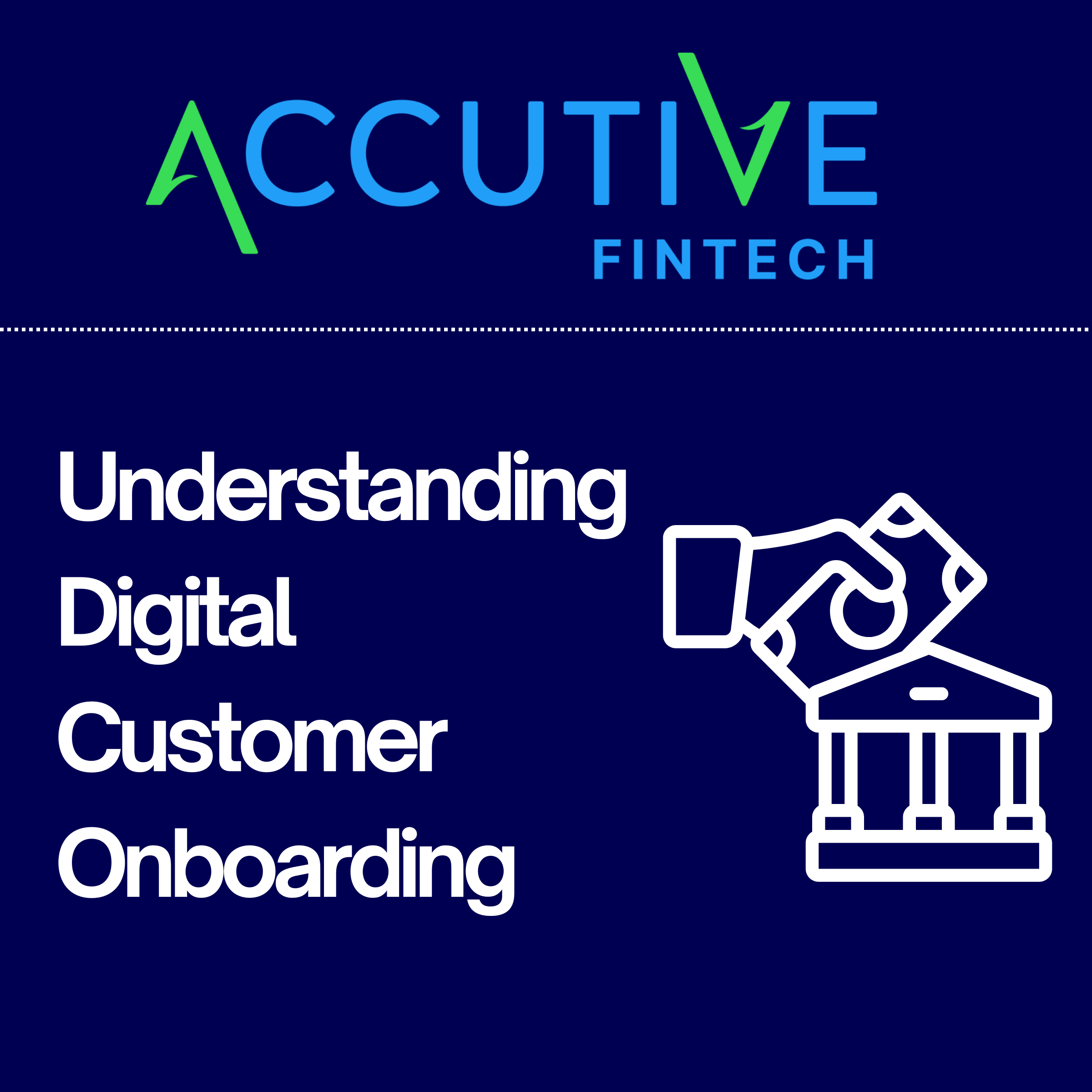Across North America, many financial institutions are facing difficult technology choices. As AI and automation technologies advance at an incredible pace, budgets remain tight and compliance risks continue to rise. Every dollar invested in technology must deliver measurable results, leaving many leaders wondering which technologies are truly transformative and which are just hype. For most, the question comes down to one decision: should we invest in AI, or focus on automation?
Artificial intelligence, especially agentic AI, holds the promise of systems that can reason, decide, and act independently. However, reaching a level of AI maturity that produces tangible business value is both expensive and complex. Many community banks and credit unions have learned that large-scale AI initiatives often require hundreds of thousands or even millions of dollars before any meaningful results appear.
By contrast, Robotic Process Automation (RPA) offers a faster, more affordable path to measurable returns. For less than the cost of a single AI experiment, financial institutions can automate repetitive processes, reduce human error, and give their teams more time for customer-facing and strategic work.
While the cost of RPA projects varies, even entry-level implementations in the low five-figure range have consistently achieved five times or greater ROI within the first year. For small and mid-sized financial institutions, that makes RPA not just a smart investment, but a practical and proven one.
Most banks and credit unions already use some kind of automation. Tools for digital onboarding, lending workflows, and compliance reviews are common. These systems help route work efficiently, but in many cases they don’t actually complete it.
Employees still spend hours entering data, checking records, and moving information between systems. In many cases, the “automation” only passes the work along to another person.
When RPA Makes Sense
RPA makes the most sense for smaller and mid-sized financial institutions that already use digital systems but still rely on people to bridge the gaps between them. Many community banks and credit unions have automated workflows for things like lending, onboarding, and compliance, yet employees still spend hours manually entering data, reconciling reports, or moving information from one application to another.
These manual steps might not seem significant on their own, but across hundreds of transactions each day, they add up to lost time, higher costs, and unnecessary risk. RPA addresses that problem directly.
It’s especially effective when:
- Processes are repetitive and rule-based. Tasks such as data entry, KYC checks, reconciliations, and document validation follow predictable steps that are easy to automate.
- Data moves between disconnected systems. RPA can transfer and verify data across platforms that don’t have built-in integrations, saving the need for costly system replacements or custom development.
- Accuracy and compliance matter. Bots perform tasks exactly as instructed and keep a complete record of every action, reducing human error and simplifying audits.
- Teams are stretched thin. By handling routine, time-consuming work, RPA allows staff to focus on customer service, analysis, and growth initiatives.
Why RPA makes sense for smaller institutions
- Fast payback: Most RPA projects deliver measurable results within 6 to 12 months, making them one of the quickest technology investments to show ROI.
- Low complexity: RPA doesn’t require machine learning, data models, or new system architecture. It works with your existing technology, which keeps costs and risk low.
- Compliance-friendly: Every action performed by a bot is logged and easy to review. This transparency supports strong governance and simplifies audit preparation.
- Business-led: RPA platforms are often designed for business users, not just IT. Visual interfaces make it possible for analysts and operations teams to manage automations with minimal technical support.
In practical terms, RPA is an affordable, low-risk way for smaller institutions to gain the benefits of automation without overhauling core systems. It helps maximize existing technology investments and creates the operational discipline needed to move toward more advanced tools in the future.
For example, a regional bank might use RPA to pull data from loan origination systems, validate information against internal policies, and update customer records automatically. A credit union could use RPA to automate daily ACH or wire reconciliations between systems that don’t integrate easily.
In both scenarios, processes that once took hours can now run automatically in minutes, improving efficiency, accuracy, and compliance while allowing staff to focus on more meaningful work.
When It Makes Sense to Go All In on AI
While RPA delivers quick and measurable results, there comes a point where automating repetitive tasks is no longer enough. For institutions that have already standardized key processes, cleaned up their data, and built strong governance practices, agentic AI can take automation to the next level.
Artificial intelligence, especially agentic AI, holds the promise of systems that can reason, decide, and act independently. Unlike traditional AI models that simply make predictions or respond to prompts, agentic AI combines reasoning, planning, and execution. It can take a goal, such as “review and approve this loan application if it meets policy”, and then determine what steps to take, which data to retrieve, and how to complete the task end-to-end without constant human direction.
In a financial services context, agentic AI could be applied in several transformative ways. A digital lending assistant could gather and verify documents, check credit policies, and prepare a loan decision package automatically. In compliance and risk management, agentic AI could continuously monitor transactions, flag anomalies, and adjust screening thresholds based on evolving risk patterns. In customer experience, AI-driven agents could proactively reach out to members who show signs of churn or help customers resolve complex service issues in real time by accessing multiple systems simultaneously.
While the potential is enormous, the path to realizing it is not easy. Reaching a level of AI maturity that produces tangible business value is both expensive and complex. Many community banks and credit unions have learned that large-scale AI initiatives often require hundreds of thousands or even millions of dollars before any meaningful results appear.
When should you consider making the AI leap?
- You’ve already mastered automation. If your institution has implemented RPA or workflow automation and most manual processes are documented and stable, you’ve built the structure that AI needs to operate effectively.
- Your data is clean and connected. AI depends on accurate, accessible data. If your core banking, CRM, and lending systems are well integrated and data quality is high, you can begin exploring predictive and decision-making AI use cases with confidence.
- You have a strong governance framework. AI introduces new responsibilities around bias, explainability, and regulatory compliance. Institutions with established data governance and audit practices are better equipped to manage these challenges.
- You’re ready to focus on insights and experience. Once your operations run efficiently, AI can help uncover new revenue opportunities, predict customer needs, and deliver more personalized experiences.
The reality for smaller and mid-sized institutions
For many smaller financial institutions, the past two years have been an AI learning and experimentation period. Dozens of credit unions and community banks have experimented with AI in areas such as chatbots, predictive analytics, and credit scoring. However, a large number have since paused or scaled back those initiatives.
The reasons are consistent: limited internal resources, competing priorities, and the challenge of fully implementing AI solutions in environments that lack clean, connected data or dedicated data science expertise. In many cases, early pilots showed promise but stalled before reaching production because they required deeper integration and long-term investment than anticipated.
The result is a growing recognition that AI alone is not a quick fix. Without a strong automation and data foundation, AI can quickly become an expensive experiment rather than a sustainable business tool. Some key realities for AI implementations:
- Short-term ROI is uncommon. Unlike RPA, which can deliver returns in months, AI projects often take years to pay off.
- The cost of entry is high. Developing and maintaining AI systems requires significant investment in infrastructure, data pipelines, and specialized skills.
- Complexity adds risk. Poor data quality or incomplete integration can undermine results and make AI outputs unreliable or non-compliant.
For smaller and mid-sized institutions, AI should be viewed as a long-term goal rather than an immediate investment in many cases. It can absolutely create value, but it must be built on a stable base of automation, clean data, and well-defined processes.
Where AI delivers strong results today
Large national and global banks are already seeing measurable returns from their AI investments. Institutions like JPMorgan Chase have successfully applied AI to fraud detection, customer support, and portfolio optimization. Their size gives them access to vast data sets, mature governance frameworks, and the financial capacity to absorb the upfront costs of development and experimentation.
For smaller institutions, it’s more effective to start small and stay focused. AI can still add value in targeted areas such as document processing, sentiment analysis, or predictive modeling for member engagement—especially when those solutions build on existing automation and integration investments.
How RPA Builds the Foundation for AI
For financial institutions that see AI in their future, RPA is the logical first step. It’s not a competing technology, but a foundation that prepares the organization for what comes next. AI depends on structure, data quality, and consistency, which is exactly what RPA provides. By automating manual work, enforcing standard workflows, and improving data accuracy, RPA creates the reliable framework that AI needs to deliver real business value.
Take loan application assessment as an example. With RPA, bots can automatically retrieve applications, extract applicant data, validate it against credit policies, and enter results into the core banking system. The process becomes faster, more accurate, and fully traceable with staff only stepping in for exceptions or edge cases.
When that same process evolves to agentic AI, the workflow becomes intelligent rather than simply automated. An AI agent could gather information from multiple internal and external sources, analyze patterns and risk factors, make recommendations, and even explain its reasoning. Instead of following a fixed set of rules, it adapts based on context and historical outcomes.
In this scenario, AI agents can take on many of the same tasks traditionally performed by lending professionals during loan assessment and underwriting. They can gather data from multiple sources, evaluate creditworthiness, compare results against policy thresholds, and generate an explainable recommendation — all within minutes. Human teams still play a crucial oversight role, reviewing exceptions and validating outcomes, but the heavy lifting of analysis and data preparation can shift entirely to AI.
In this way, RPA handles the repetitive, rule-based work that builds structure and trust in automation, while agentic AI adds reasoning and adaptability on top. For smaller financial institutions, the progression is clear: start with RPA to create clean data and efficient workflows today, then expand into AI-driven decision-making when the organization and infrastructure are ready.
How RPA prepares your institution for AI success
RPA helps build the foundation for an AI-empowered digital transformation by:
- Creating clean, consistent data: Every automation captures information in a predictable format, reducing data errors and duplication. This consistency makes future AI models more accurate and reliable.
- Documenting and standardizing processes: RPA requires institutions to map out each step of a task before automating it. That documentation becomes invaluable when training AI to understand and replicate those same processes.
- Building operational discipline: Automation introduces structure, measurement, and accountability. These controls provide the governance framework that AI later depends on to operate safely and transparently.
- Connecting systems and data sources: When paired with platforms like MuleSoft, RPA acts as the glue between legacy systems and modern applications, ensuring that data flows smoothly and securely. This integration gives AI access to the right information without increasing risk.
- Improving confidence and readiness: Each successful RPA project helps teams build comfort with automation, change management, and data-driven decision making — skills that are critical when scaling into AI.
In simple terms, RPA helps turn institutional knowledge into digital logic. It transforms scattered, manual processes into structured, automated systems that AI can learn from and enhance later.
|
Without RPA |
With RPA as a foundation |
|---|---|
|
Manual, inconsistent workflows |
Standardized and well-documented processes |
|
Disconnected systems and data silos |
Integrated, automated data flow |
|
Unstructured, error-prone data |
Clean, machine-readable data ready for AI |
|
Limited visibility and control |
Transparent, auditable automation environment |
RPA brings predictability and order to day-to-day operations, giving AI a clean, stable environment to work within. For smaller financial institutions, that’s the most important step — transforming today’s repetitive tasks into tomorrow’s intelligent capabilities.
From RPA to AI: A Practical Roadmap
For most small and mid-sized financial institutions, the smartest path forward isn’t choosing between RPA and AI: it’s sequencing them. Successful modernization happens in stages, starting with proven automation and building toward intelligence as systems, data, and governance mature.
At Accutive FinTech, we often describe this as the RPA to AI Roadmap. It’s a structured, results-driven approach that helps financial institutions unlock measurable value at each stage of their automation journey.
Step 1: Start with an Automation Assessment
The first step is understanding where automation can make the biggest impact. Accutive FinTech’s Automation Assessment provides a clear picture of which manual processes can deliver the highest return, what systems are involved, and how automation can integrate across the organization.
Our team works directly with business and IT stakeholders to:
- Identify high-volume, high-effort processes that are strong automation candidates.
- Evaluate current workflows, data quality, and integration points.
- Estimate time and cost savings using RPA versus manual execution.
- Develop a phased roadmap that aligns with your institution’s size, goals, and compliance obligations.
This assessment ensures that automation investments are targeted, achievable, and measurable while avoiding the common pitfall of trying to automate everything at once.
Step 2: Implement RPA for Quick Wins
Once priority areas are identified, the next step is execution. Accutive FinTech delivers RPA Implementation Packages starting at $19,850, designed to help institutions achieve quick wins and measurable ROI within weeks or months, not years.
Our implementations use leading RPA platforms such as:
- MuleSoft RPA for institutions already using MuleSoft for integration, enabling bots to operate alongside APIs and workflows.
- Microsoft Power Automate for organizations within the Microsoft ecosystem, offering seamless integration with Office 365, Dynamics, and Teams.
- Other enterprise-grade RPA platforms where required to support legacy or specialized systems.
These implementations typically target tasks like data entry, loan reconciliation, account maintenance, compliance reporting, or KYC validation — areas where repetitive manual work can be replaced by consistent, rule-based automation.
Each deployment includes governance setup, ROI tracking, and staff enablement, ensuring that automation continues to deliver value long after implementation.
Step 3: Expand and Connect
After initial success, the next phase focuses on scaling and connecting automation efforts across departments. This often involves:
- Integrating RPA bots with APIs using API integration platforms, such as MuleSoft Anypoint Platform, so data can move securely and automatically between systems.
- Expanding automation to additional functions like treasury, risk, and lending operations.
- Establishing a centralized dashboard to monitor performance, uptime, and ROI for all automation assets.
This phase helps move from isolated wins to enterprise-wide efficiency, which is a necessary step before introducing AI into daily operations.
Step 4: Prepare for Intelligent Automation
Once processes are standardized and connected, the groundwork for AI is complete. At this stage, institutions can safely explore AI-enhanced automation — adding intelligence to existing workflows to make them adaptive and context-aware.
Examples include:
- Using AI for document classification or data extraction within automated onboarding or lending processes.
- Embedding predictive analytics into RPA workflows to forecast customer needs or detect potential fraud.
- Integrating natural language processing (NLP) tools to improve communication between bots and users.
These incremental applications allow institutions to test and refine AI capabilities without major risk or cost.
Step 5: Move Toward Agentic AI
With the right data quality, process maturity, and governance in place, institutions can begin adopting agentic AI systems capable of planning, learning, and making complex decisions independently.
At this stage, AI doesn’t just execute steps; it identifies opportunities, predicts outcomes, and dynamically adjusts processes. Examples might include:
- Loan underwriting agents that evaluate multiple data sources, recommend approvals, and flag exceptions.
- Compliance agents that monitor transactions in real time and escalate only high-risk cases.
- Customer engagement agents that personalize offers or responses based on behavioral insights.
While this level of automation is still emerging, institutions that have laid the right RPA and data foundation will be best positioned to adopt it quickly and safely.
RPA and AI Together: Building a Smarter Future
For most growing financial institutions, the future won’t be a binary choice between RPA and AI – it will be an embrace of these complementary technologies as part of a phased digital transformation and modernization journey. RPA delivers efficiency, accuracy, and structure. AI builds on that foundation to drive insight, personalization, and long-term growth.
For smaller and mid-sized financial institutions, the combination of RPA today and AI tomorrow offers a balanced path: immediate ROI now, with a clear runway toward future innovation.
Accutive FinTech helps banks and credit unions modernize with confidence, delivering end-to-end automation and integration solutions tailored to your goals and scale.
Our RPA Implementation Packages start at $19,850 and typically achieve five times or greater ROI within the first year. Each engagement begins with a structured Automation Assessment to identify the highest-impact opportunities, followed by implementation using leading platforms like MuleSoft, Microsoft Power Automate, or other enterprise-grade RPA tools.
Whether your institution is looking to automate back-office operations or build the foundation for AI-driven innovation, Accutive FinTech provides the expertise, strategy, and technology to get you there — efficiently and securely.








